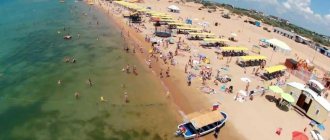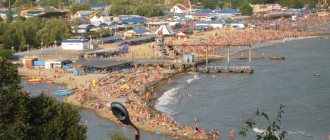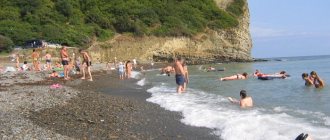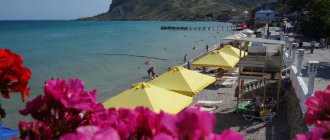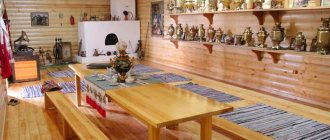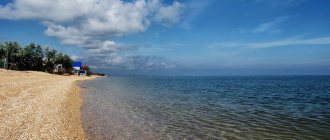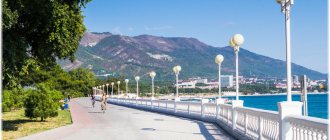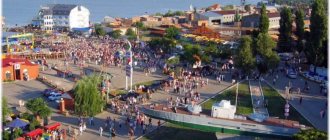Zelenogradsk
History of Zelenogradsk
Plan of the surroundings of modern Zelenogradsk for the Viking Age.
Palaeotoponyms in this microregion are noted. The history of Zelenogradsk dates back to the 13th century. In this century, the knights of the Teutonic Order invaded the lands where the city is located today, intending to convert the ancient Prussian Samb tribes living here to Christianity. This region, which occupies the entire territory of the modern Kaliningrad Peninsula, is known in historical chronicles as Sambia or Zemland (Zamland). From chronicles dating back to 1240, it is known that at that time there was already a settlement of Prussian fishermen here. In 1252, in this place, at the very beginning of the Curonian Spit, the Teutons established a small protected inn with the Krantsa Krug tavern. It is believed that the name came from the Prussian word “krantas”, meaning “precipitous shore”. Warriors used the Krantsa Circle to rest after long marches across the Curonian Spit, along which the shortest route between the southern and northern lands of the order ran. In 1258, a Teutonic settlement is mentioned in historical chronicles under the name Kranzkuren, which later transformed into Kranz.
Around 1283, Neuhaus Castle, later renamed Gluckemburg, was built near Kranzkuren to protect against Lithuanian raids. It lost its strategic importance in 1308, when Lithuanian soldiers burned Kranckuren, and the castle fortifications were badly damaged.
Kranzkuren was rebuilt, and for several centuries remained a small village where people lived mainly from fishing. It is known that in 1785 Kranzkuren, which included 40 “hearths,” was under the patronage of the Prussian king and was part of the kreis (district) of Fischhausen of the Königsberg district.
Embankment in Kranz, 1900
The idea of turning Kranz and other settlements on the Baltic Sea coast into a resort area arose at the end of the 18th century. It belonged to Ludwig von Batsko, a professor at the University of Königsberg, who noticed that in this region the number of elderly people is much higher than in other regions of Prussia. The idea was developed by professor of medicine Metzger, who published an article about the benefits of sea bathing for health and the healing nature of the local air, and medical adviser Friedrich Kessel chose Kranz to develop the health resort. In 1800, King Frederick William III ordered the development of a government program to create a resort in Kranz. From 1816 it became known as the Royal Resort. The season here officially began on May 15, which was accompanied by the raising of the flag in the main city square. It was lowered on September 15, which symbolized the end of the season.
Kranz quickly gained popularity, fishermen's huts were pushed to the outskirts, and the coast was built up with miniature houses with original architecture. The buildings served as hotels, boarding houses, or furnished rooms for vacationers were set up within their walls. In 1821, the first large hotel, the Lugerhouse, appeared at the resort. In 1835, the hotel was destroyed by fire, but it was rebuilt in the best possible way. The Prussian king Frederick William IV, who visited Kranz after the completion of the restoration work, was so impressed by what he saw that he allocated additional funds from the treasury for the further development of the resort infrastructure. Some of them were spent on laying out the magnificent Plantage park and birch alley.
Zelenogradsk in 1945
Back in 1853, Kranz and Konigsberg were connected by a route along which stagecoaches ran according to a schedule, and already in 1885 the cities were connected by a railway line. On the eve of the First World War, up to 10,000 people vacationed annually in Kranz, which became famous far beyond the borders of the German province of East Prussia. The city hosted three dozen boarding houses and hotels; along the Curonian Spit there were specially equipped baths, which could be reached by regularly cruising steamships. The sky above Kranz was often lit up with fireworks, and life here was in full swing until late at night. During the war, the resort was deserted, but after it ended everything returned to normal.
The outbreak of World War II did not come as a shock to Kranz - military operations bypassed him. Only in 1944 was the idyll destroyed: many residents of Königsberg, frightened by the bombing of the city, began to move to Kranz, and a German military hospital and a communications point were set up near the resort. In February 1945, Soviet troops entered the city, and the German period in the history of the resort city ended. Kranz was renamed Nakhimovsk and then Zelenogradsk. In the first post-war years, Soviet soldiers healed their wounds here, and the secular resort life in the city froze for many years. In Zelenogradsk there were trade union sanatoriums, a holiday home for medical workers, children's health camps, and Kaliningrad residents came here on sunny summer days to swim and sunbathe on the local beaches. In the mid-90s of the last century, Zelenogradsk became a popular holiday destination among our compatriots. In 2000, it received the status of a federal resort.
Geography and climate
Zelenogradsk is the administrative center of the Kaliningrad region, located on the peninsula of the same name. The city is located at its northern tip, from where the Curonian Spit stretches, separating the Curonian Lagoon from the Baltic Sea. The spit extends 98 km in a northern direction and leads to Klaipeda, located in the west of Lithuania. On this narrow piece of land there is the Curonian Spit National Park, it is the smallest in Russia and at the same time one of the most visited in the country.
National Park "Curonian Spit"
To the northwest of Zelenogradsk, at a distance of about 27 km, is the resort town of Svetlogorsk, in the southeast, 35 km, is Kaliningrad. You can get from Moscow to Zelenogradsk along different routes, the minimum distance is 1255 km, from St. Petersburg – 966 km. Local time is one hour behind Moscow.
"Dancing Forest"
A yellow strip of sandy beaches stretches along the entire coast of Zelenogradsk. In some areas, about once every six months, you can observe a unique phenomenon: the Baltic Sea, having retreated 10-15 meters from the coast, exposes the coastal shelf, and bizarrely shaped stumps and tree roots appear before your eyes. They are not completely fossilized, which gives scientists reason to believe that only about 300 years ago a pine forest grew along the coastline.
The indigenous section of the Curonian Spit, adjacent to the eastern outskirts of Zelenogradsk, demonstrates natural diversity. Here pine and deciduous forests alternate with reed fields and numerous black alder forests covering the marshy, swampy shores of the Curonian Lagoon.
The climate of Zelenogradsk is characterized as transitional from marine to continental. It is called moderate, and this definition exactly corresponds to each of the seasons. In summer it is warm here, but there is no heat; daytime air temperatures usually vary around +20 °C. At the end of July and August, the thermometer sometimes rises to +25 °C or slightly higher. Winters in Zelenogradsk are quite mild - the air temperature rarely drops below -8 ° C, but the wind blowing from the sea can be piercing.
Storm in Zelenogradsk
Autumn in the city is warmer than spring. In September during the day it’s about +15…+17 °C, in November – up to +6 °C. Temperatures drop below 0 °C only in mid-December. The first spring month in Zelenogradsk is cool, usually street thermometers record readings not exceeding +5 °C; in May the air warms up to +15...+17 °C.
The Baltic Sea cannot be called warm. In the first summer month, only seasoned citizens swim here, for whom the water temperature is comfortable: +15...+16 °C. In July-August the sea warms up to +18...+20 °C, and sometimes even to +22 °C. In September the water is still relatively warm - about +17 °C, but in November it already cools down to +12 °C.
Sights of Zelenogradsk
Resort life in Zelenogradsk flows steadily in its central and eastern parts. The western area, built up in the Soviet era with houses of the same type, is of no interest to tourists. The exceptions are the railway station building, built at the end of the 19th century and recently restored, and the old park with a pond. The reservoir is known as Tortilin Pond - scenes with the wise turtle for the film “The Adventures of Pinocchio” were filmed here. The park has slides for children, volleyball courts, and fishing spots near the pond.
Zelenogradsk, like every seaside city, has its own promenade. It stretches along the sea, representing a wide alley 1.1 km long and a promenade pier extending 150 meters into the sea. The reconstruction of the promenade, which lasted 5 years, was completed in 2013, and today it looks very modern and elegant, both ends smoothly transition into park areas. There are paths for cyclists, outdoor exercise equipment, and nice benches and original sculptures along the entire route.
Promenade of Zelenogradsk
It is incredibly pleasant to walk here at any time of the year and in any weather, even during a storm. The views of the Baltic Sea from the embankment are excellent, especially at sunset. After sunset, the promenade is illuminated by numerous lanterns, which gives this corner of Zelenogradsk a romantic charm.
Cafes and restaurants line the embankment. In summer there is no crowd here with people wanting to try ice cream, drink coffee or refreshing drinks. During the cool season, city establishments are quiet and cozy; hot, spicy mulled wine becomes very popular. Holidaymakers strolling along the embankment with a glass of this warming drink in their hands is a typical illustration of the winter landscape of Zelenogradsk.
Pump room "Queen Louise"
A famous landmark of the promenade is the Queen Louise pump room. It was installed here in 2006 by one of the local patrons. The pump room is named after the Prussian queen, who stayed in the city during her dramatic journey along the Curonian Spit from Konigsberg to Memel (Klaipeda), where she fled to escape the invasion of Napoleon's troops. A beautiful brick gazebo is built near a spring with mineral water coming from a depth of 240 m. This water is slightly mineralized and very tasty, although slightly salty. Vacationers and locals bring or bike containers with them to collect as much water as they want. There are several taps here, but the water pressure is weak. The pump room is not open in winter.
A small square near the promenade is also named after Queen Louise. In this quiet, secluded place there is a bust of the Queen, and in the very center there is a long-lived elm tree. According to legend, it was planted in 1843 by Louise’s son, the Prussian king Frederick William IV. Not far from the square, above the greenery of trees and tiled roofs of ancient buildings, the slender tower of the Orthodox Transfiguration Cathedral, a former Lutheran church built in 1898 in honor of St. Adalbert, rushes into the sky. Services are regularly held in this beautiful building with high vaulted ceilings, which is announced by the ringing of bells cast specifically for the cathedral in Voronezh. The temple is open to the public from 09:00 to 20:00 on weekdays, and from 08:30 to 21:00 on weekends.
Church of St. Andrew the First-Called
Building on Kurortny Avenue
Water tower in Zelenogradsk
It is also interesting to see the Church of St. Andrew the First-Called, consecrated in 1998. This is the first Orthodox church in Zelenogradsk. The red brick building with green spiers was previously a Catholic chapel. Adjacent to the church is a nice, well-kept courtyard with a children's playground.
Another ancient landmark of Zelenogradsk is the water tower. This forty-meter building, which is a symbol of the city, can be seen from all its corners. The top of the tower, which from a distance resembles a hovering flying saucer, is equipped with an observation deck. To admire the beautiful panoramas from here, you need to take the elevator.
The tower houses the lovely Murarium cat museum. In his art collection, furry pets are presented in the form of toys, figurines, jewelry, and there are knitted, sewn, and painted cats. Some of the exhibits are kitsch, and some are almost high art. Viewing the exhibition will cost 150 rubles.
Next to the Murarium is the Museum of Skulls and Skeletons. This place is not scary at all, but very funny, but visiting the exhibition is still not recommended for children under 6 years old. The museum is divided into educational and interactive zones; specific medical information is presented here in an entertaining and humorous manner. The bright and cheerful attraction “Ribbon Maze” is considered by some to be creepy, while others go through the labyrinth again and again if they did not find a way out of it the first time.
Murarium
Completely different a. This museum contains a unique collection of figurines, figurines, dolls of angels and angel-like creatures. Among the exhibits are bright original works.
Museum of Skulls and Skeletons
"House of Angels"
Zelenograd Museum of Local Lore
The Zelenograd Museum of Local Lore is the largest in this resort, which is traditional for cities with a rich history. The museum is housed in a mansion that was built at the beginning of the last century and until 1945 belonged to the family of the well-known lawyer Max Krell throughout the area. The building was built according to an original design, which combines elements of Russian architecture and Gothic. The museum exhibition occupies two floors and includes 5 locations dedicated to different eras, starting from ancient times. There is also a souvenir shop and a tourist information center, which offers excursions to interesting places in the Kaliningrad region. The museum is open from 10:00 to 18:00; the exhibition is closed on Mondays. The entrance ticket costs 100 rubles.
Heading from the museum along the streets of Zelenogradsk in an easterly direction, you will find yourself in an area with pre-war buildings. The narrow streets of ancient Kranz, lined with paving stones and cobblestones, will take you past beautiful buildings built at the end of the 19th and beginning of the 20th centuries. In some places, houses with half-timbered (frame) construction dating back to an earlier period have been preserved. Among the many original mansions, the building of the Kurhaus Kranz Hotel stands out, which opened its doors back in 1843 and was the main hotel of the city, the center of the resort life of vacationers.
The eastern district of Zelenogradsk attracts tourists with “frying pan” beaches - the so-called miniature sandy glades between the dunes, protected from the Baltic winds by low-growing bushes and trees. You can sunbathe on the “pans” from mid-April until late autumn. In the same part of Zelenogradsk the Zelenogradka River flows, where you can successfully go fishing. The main catch is well-fed crucian carp and roach.
Beaches
The coastline of the Zelenograd urban district is about 11 km, of which 4 km have been developed and turned into a recreation area. The developed coastline is a single beach location, over part of which there is a promenade. The beach strip is almost entirely covered with fine and soft golden sand, but in some places it is mixed with pebbles. Changing cabins, toilets (for a fee), kiosks with drinks and food are located on the embankment. In summer, lifeguards are on duty on the beaches from 10:00 to 18:00. The entrance to the sea here is convenient, very gentle, and in order to fully swim, you need to reach almost the end of the breakwaters; they are installed everywhere here.
The coastline within the city is conventionally divided into western and eastern beaches. The point of separation is considered to be the Queen Louise pump room, from which a pleasure pier extends into the sea. On both sides of it, the beach strip is so small that sometimes, during storms, it is completely hidden under water.
Zelenogradsk beach
The beaches in the eastern part of Zelenogradsk are narrower than those in the west, but the section of the promenade that stretches above them is more popular with tourists. Concerts and entertainment events are held on Wind Rose Square. Near the square there is a play area for children and a bicycle rental point. Closer to the city park, the wide promenade merges with a narrow wooden deck, but the coastal line here becomes wider. The beaches continue behind the equipped embankment. They are equipped with courts for beach volleyball, and there are rental points for equipment for water activities. Further along stretch the ridges of low dunes, where the famous “frying pans” are hidden. There is an opinion that a tan acquired there has a special, bronze, tint. The largest “frying pan” closes the eastern beach area. There are always a lot of young people here, enthusiastically playing volleyball or hanging out in the nearby bar-restaurant.
The promenade, stretching along the wide and spacious western beaches, also has recreation areas, cafes, sports and children's playgrounds. Stairs lead from the embankment to the sea. Closer to the outskirts of the city, the beach strip narrows; there is almost no tourist infrastructure here. Outside the city, the Zelenograd beach meets the coastal strip of the village of Malinovka.
Among the water sports on the beaches of Zelenogradsk, surfing and SUP are popular. At the address: 2nd Primorsky Lane, 1, there is a surf school Baltic SUP & SURF. One lesson, which lasts an hour and a half, will cost 1,500 rubles.
Treatment
In Zelenogradsk, which initially developed as a mud-curing, climatic and balneological resort, today there are 4 sanatoriums. They specialize in the treatment of cardiovascular, neurological, gynecological diseases, and providing assistance to people with problems with the musculoskeletal system. The best sanatoriums are “Zelenogradsk” and “Chaika”. For treatment, both health resorts use peat mud from the famous Goreloye tract located near the city.
The Zelenogradsk sanatorium building is located in the eastern part of the resort, near the place where the Curonian Spit begins. The distance to the sandy beach is 20 meters. Commercial (without benefits) cost of one place – from 1416 rubles per day (without treatment, but with breakfast, lunch, dinner). Full board + treatment will cost from 1,600 rubles per bed per day. Those interested can order 5 meals a day according to one of nine diets recommended by a doctor. The sanatorium has a gym and billiards rooms, a solarium, a cinema hall, and a dance floor.
The nine-story building of the Chaika sanatorium is located near the promenade, 150 m from the city beach. It is often used as a regular hotel. The medical building and the dining room are located next to the main building. Daily accommodation in a single room will cost from 2490 rubles.
Zelenogradsk from above
Souvenirs
Antique shop “Flea Marketer”
Tourists from different parts of Russia quite rightly believe that returning home from Zelenogradsk without an amber souvenir is simply unacceptable. The Amber Region, as the Kaliningrad region is often called, is the world record holder for the extraction of petrified fossil resin, whole kilogram pieces of which are equated to precious stones. Zelenogradsk shops sell all kinds of amber products. This could be a tiny mouse worth 50 rubles, which you will be advised to carry in your wallet so that money is not transferred, or jewelry - a set of jewelry costs from 1000 rubles. Designer jewelry will cost many times more. You can become the owner of an amber souvenir completely by accident, while walking along the seashore, but some holidaymakers do not rely on chance, but turn into treasure hunters, carefully examining the sand where “pieces of the sun” may be hiding. Experienced treasure hunters advise looking for amber in algae brought in by a recent storm.
Beautiful wood products can be purchased during an excursion to the Curonian Spit. The Museum of Russian Superstitions, located in those parts, sells original carved talismans and amulets.
In the very center of Zelenogradsk, on Kurortny Prospekt, 27, there is a nice antique shop “Flea-Holder”. Here you can buy unusual things, cute postcards and paintings with views of the city, original figurines, kitchen items, aromatic tea, and fragrant soap made according to ancient recipes. All products are sold in elegant souvenir packaging.
House on Turgenev Street
Shop on Lenin Street
Kitchen
You will, of course, find many fish dishes on the menu of culinary establishments in Zelenogradsk. Be sure to try hot smoked eel, Baltic herring with potatoes, potato pancakes with salmon.
You won't find luxury restaurants at the resort, but there are plenty of cute cafes here. Most of them are located along the embankment. It’s worth checking out the Old City cafe, located at 34 Moskovskaya Street, not far from the water tower. This nice establishment is located within the walls of an old German villa. The menu includes European cuisine; in summer you can book tables on the outdoor terrace.
Cafe "Old Town"
Cafe "Am!Bar"
Near the sea there is also one of the most popular cafes in the city, Am!Bar. Tables here are booked in advance. Prices are moderate: for example, a portion of potatoes with herring costs 300 rubles, a glass of aromatic mulled wine costs 200 rubles.
You can have a hearty and inexpensive meal in the cafe with German cuisine “Bretzel”, which is a five-minute walk from the embankment. On weekdays it is worth stopping by for a business lunch. A delicious meal of pea soup, cod with vegetables, and carrot cake will cost 280 rubles. The best pizza, judging by the reviews, is prepared in the Ura cafe at 2 Kurortny Prospekt.
For those with a sweet tooth, we recommend going to the Chopin cafe at the Queen Louise Hotel. The desserts for which this establishment is famous cost from 150 rubles per serving. On the Windrose Square there is a gelateria called Labar. They sell delicious gelato made from natural cream, berries, farm milk, and Italian chocolate. A serving of this delicacy accompanied by a milkshake will cost 300 rubles.
Where to stay
Zelenogradsk Spa Hotel
There is quite a large selection of accommodation in Zelenogradsk. There are no five-star hotels here, but there are two four-star hotels. Right on the seashore there is a 4* Zelenogradsk spa hotel. Within the walls of this elegant building there are 28 comfortable rooms, a spa center, a sauna complex, and a restaurant. The price range for daily accommodation is from 3170 to 7150 rubles per room.
Near the railway station, a five-minute walk to the sea, there is a small hotel “Loger House” 4*. It is decorated in a classic style and attracts tourists who appreciate a romantic atmosphere and comfort. You can rent a room here from 1820 rubles per day.
You can stay in a modern and stylish hotel and entertainment center. This boutique hotel, located near the water tower, is part of a tourist mini-zone that includes the Murarium and House of Angels museums. The hotel has a break area where you can make tea, coffee, and use household appliances. There is free covered parking nearby. Daily accommodation will cost from 2630 rubles per room.
Boutique Hotel PARADOX
Lougher House
Hotel Sambia
Hotel Princess Eliza
Popular three-star hotels in the eastern part of the promenade are the Princess Eliza, where the rooms are decorated in an ancient style, and the Sambia with an indoor pool open all year round. You can stay in the guest house “20 Meridian”.
In the western part of the beach, the popular hotels are “Golden Mile” 3*, “Apriori” 3*, and apartments “Belaya Vorona”.
Booking.com
Transport
Zelenogradsk in winter
You can easily get around Zelenogradsk on foot, and, even more so, by bike. Buses and minibuses connect the city with surrounding villages, as well as with Kaliningrad and the resort Svetlogorsk. They set off from the bus station located in the city center. Taxis also serve these routes; in addition, citizens and tourists often use this type of transport to get to distant beaches on the eastern outskirts and to the Curonian Spit National Park.
In the city, it is better to rent a bicycle than a car. An hour's rental will cost approximately 80 rubles, a day - from 400 rubles. Bicycle rental services are available at most hotels. A number of hotels may offer you to rent a car, but keep in mind that moving around the narrow streets of Zelenogradsk on four wheels is extremely difficult. And if you want to get to know the surrounding attractions or other cities in the region, it is better to rent a car directly in Kaliningrad upon arrival there.
How to get there
Transfiguration Cathedral in Zelenogradsk
Tourists get to coastal Zelenogradsk through Kaliningrad. This city is connected to Moscow and St. Petersburg by direct air and railway lines. Every day, planes from six airlines fly from the capital airports Sheremetyevo, Vnukovo, and Domodedovo to Kaliningrad airport Khrabrovo. The journey by air takes from 1 hour 50 minutes. up to 2 hours 10 minutes The cheapest tickets are offered by the Pobeda air carrier - from 4,300 rubles round trip. Three airlines operate direct flights from St. Petersburg Pulkovo Airport 2-3 times a day, depending on the day of the week. The flight takes from 1 hour 40 minutes. up to 1 hour 50 minutes
During the period from May 1 to September 30, the most convenient way to get from Khrabrovo airport to Zelenogradsk is by minibus No. 243-E. Transport runs three times a day (10:25, 14:25, 18:55) and follows the route Khrabrovo - Svetlogorsk, making stops in the Pionersky village and Zelenogradsk. The distance between the airport and the Zelenogradsk bus station is 25 km, travel time is 40 minutes. The fare is 140 rubles.
At other times of the year, you can only get directly to Zelenogradsk from the airport terminal by taxi (from 800 rubles) or by rented car. It is convenient to book a taxi in advance; this can be done by going to the KiwiTaxi website.
You will have to get to the resort by public transport through Kaliningrad. From the stop near the airport terminal, buses depart at intervals of 40 minutes to an hour to the Southern Bus Station. The route is served from 08:20 to 22:00. The fare is 50 rubles.
Buses No. 140, 141, 114 run from the Southern Bus Station to Zelenogradsk. They run every hour (No. 114 less often) from 06:00 to 22:00. A ticket will cost 77 rubles.
The bus station is located in close proximity to the Southern railway station, where trains from Moscow and St. Petersburg arrive. From here you can go to Zelenogradsk by train. Since February 2022, trains run 6 times a day daily from 06:40 to 17:30, with two more flights (18:40 and 19:57) operating only on weekdays. Travel time takes 40-45 minutes. A fast train departing at 10:30 will take you to Zelenogradsk in just half an hour.
Calendar of low prices for air tickets
What to see
Both on the central beach in Zelenogradsk and in its surroundings there are many attractions and cultural monuments that deserve special attention. One of these is the Queen Louise pump room we mentioned earlier with mineral healing water, covered with a red brick tent. There you can see a sign where the beneficial properties and chemical formula of artesian water are described in German. In the same area there is another historical monument that attracts many tourists - the Kranz Resort Administration Building in the Art Nouveau style of the early 20th century.
To the west of the pier, which extends far into the sea, you can find the granite sculpture “Grey Baltic Seal,” which was installed in 2013 because a year earlier, a seal, a member of the endangered species, lived for several months on the beach in Zelenogradsk. In general, it is worth noting that in autumn and spring seals often crawl ashore. Tourists can also see a small but extremely funny monument to a cat at the very beginning of the pier. Zelenogradsk is truly famous for its love of cats; their images and figures are found everywhere, even on some traffic lights, which is a unique feature of the city.
You can learn more about the culture of this unusual town by visiting the Zelenograd City Museum of Local Lore, located literally a five-minute walk from the central beach on Lenin Street. They say that most visitors are satisfied.
Baltic seal, © Leonid Sikorsky
Which beaches in the city are sand or pebbles?
The coverage of Zelenograd beaches is predominantly pleasant fine golden sand, in some places mixed with pebbles . The city's beaches are famous for their sandy glades between dunes, surrounded by trees and bushes. Thanks to this location, such places, called “frying pans,” are almost inaccessible to the wind and warm up perfectly, allowing you to sunbathe even in early spring.
The advantage of Zelenogradsk beaches is a flat bottom and gradually increasing depth , which is safe for vacationers with children . Breakwaters are installed in the water.
Real estate prices
Investment in construction projects in Zelenogradsk is in full swing. Mostly the Eastern district is being built up, next to which is the famous Skovorodka beach. Often, apartment buildings are built on five floors, and the complex includes up to 11 houses. The area has German-style architectural buildings, as well as some Soviet high-rise buildings. Infrastructure includes a hospital, a private clinic, Victoria and Family food outlets. From here there is access to the highway to Svetlogorsk and Kaliningrad.
Population
| Population | ||||||
| 1959[7] | 1970[8] | 1979[9] | 1989[10] | 1992 | 1996[11] | 1998[11] |
| 6866 | ↗9172 | ↗9781 | ↗10 786 | ↗11 200 | ↗11 600 | ↗12 200 |
| 2000[11] | 2001[11] | 2002[12] | 2005[11] | 2006[11] | 2007[11] | 2008[11] |
| ↗12 400 | ↘12 300 | ↗12 509 | ↘12 300 | →12 300 | ↘12 200 | ↘12 100 |
| 2009[13] | 2010[14] | 2011[11] | 2012[15] | 2013[16] | 2014[17] | 2015[18] |
| ↘12 070 | ↗13 026 | ↘13 000 | ↗13 043 | ↗13 155 | ↗13 592 | ↗14 308 |
| 2016[1] | ||||||
| ↗14 830 | ||||||
Transport
The Zelenogradsk-Novy station of the Kaliningrad railway is located in Zelenogradsk. This station belongs to the Kaliningrad - Zelenogradsk - Svetlogorsk railway line. In the 1980s, in the summer, every day from Kaliningrad to Zelenogradsk, trains ran at intervals of 15 minutes, the journey took an average of 35 minutes, a ticket cost 25 kopecks, a monthly pass cost 1 ruble. 80kop. As of 2014, there are 5 trains a day from Kaliningrad to Zelenogradsk on weekdays, 6 trains back, and 4 trains back and forth on weekends, the journey takes 40-45 minutes. Regular buses deliver passengers to Kaliningrad, the Curonian Spit, cities and towns of the region. The regional center and Zelenogradsk are connected by the first stage of the Primorskoye Ring highway.
